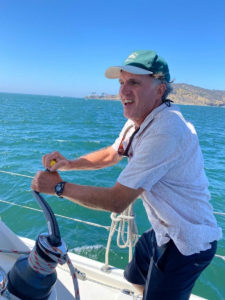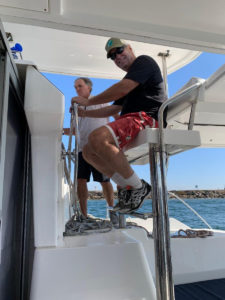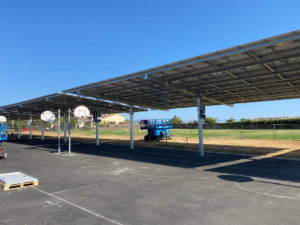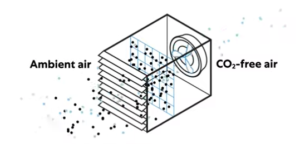September 22, 2021 – Volume 23, Issue 9
In This Issue
- Flanigan’s EcoLogic: Climate Optimism
- Hybrid Sailing on the Ramblin’ Rose
- EcoMotion Joins California Clean Air Day Pledge
- Los Angeles Accelerates Climate Pledge
- U.S. Solar Futures Study
- Decarbonizing Shipping
- NETs: Direct Air Capture
- Amazon Shout-Out
- Carbon-Negative Cement

Flanigan’s Eco-Logic: Climate Optimism
Call me nuts. Sure, the eco-system is hugely taxed. In some ways it is clear that the sky is falling.
Devastation is its proof. The climate is screaming… more intensely, more frequently… with greater ferocity. The fires, the floods, hurricanes, and tornadic activity. I am fully aware of it all. And, I am optimistic. This is the time for action… and lots of it… and fast.
It wasn’t the way I wanted to spend lunch with Laurie. It was a glorious summer day in Burlington, Vermont. Bright sunshine; crystal clear air; billowing clouds. Terry and I made a special exception to our family-only East Coast trip to drop in on Laurie and and his wife Laura, the LaLa’s as they are known in their singing group! Laurie’s a childhood friend, our sailing captain, builder of my favorite guitar, energy efficiency expert, green builder extraordinaire… as close to family as it gets. He’s a great bud. But he’s down.
Too much climate reality. He stated clearly that he wanted me to give him some hope. We drove past old Burlington watering holes, the Sheik, the Chicken Bone. Please raise me up! Laurie wanted me to convince him that one can be optimistic in light of it all. Ugh… I wasn’t really jazzed about making a pitch to a skeptic that day. Hey, I’m on vacation! Just give me a turkey sandwich! No. All set for a heady lunch at “The Spot?” Nice shade, good food, lots of boating going on… great views out over Lake Champlain to the Adirondacks. But back to work as an eco-advocate!
We’ve got this. From a technical standpoint, we can indeed craft a sustainable, global society. And, we’ll craft a higher quality of life when we do so. It’s about living smart, like mixed zoning to allow for people to work close to their homes… obviating the need for cars and commuting and costly infrastructure and headaches that it requires and festers.
The pandemic has taught many of us how to live and work at home and to take on healthy habits. In our sustainable future, there will be more time for family and friends, less focus on the materialism that has clearly been part of our elevated footprint.
The breadth and creativity of the sustainability movement is fantastic, from highly cost-effective carbon mitigation strategies, to values-based ventures. The New York Times ran a story that introduced the notion of carbon-free delivery using sailboats. The schooner Apollonia sails the Hudson River bringing organic wares to markets in New York City. One of the ship’s captains put the national, uber-fast delivery craze in perspective, “Some things need to be overnighted; most things don’t… There’s an incredible carbon footprint to that speed.”
Wherever I look, whatever sector we explore, be it mining, vehicle manufacture, agriculture, tourism, shipping, or steel making, I am blown away by the marvelous pace of innovation. How about solar-powered, ocean-faring shipping? It has the potential to cut shipping emissions by 90%. Not a fringe activity: Shipping-giant Maersk, the world’s largest operator, is exploring wind-powered shipping. Back on land, all Dutch trains are wind powered. The 100% goal was accomplished a year early. Rule of thumb: One wind turbine can produce enough power in one hour to propel a train 120 miles.
The pace of innovation is staggering. The collective vision is driving solutions. Last month’s EcoNet featured a piece on fossil-free steel, unthinkable just a few years ago. We’re used to blast furnaces! This issue of EcoNet News features “green cement.” Cement production, like steel, accounts for about 7 – 8% of global greenhouse gas emissions. If both steel and cement can be transformed into carbon neutral or negative products… that’s 14 – 16% of the climate problem right there! My favorite mentor, Amory Lovins, takes it a step further, or backwards perhaps, fundamentally questioning the need for these heavy building materials that seem to coexist for each other. Why not design smart and light?
Carbon capture is expensive now and may well be part of our salvation. NETs… Negative Emissions Technologies can be as simple as tree planting programs and tweaking agricultural practices. Let’s plant billions of trees. NETs can also be complex. Iceland just fired up the world’s largest carbon capture machine. It’s called Orca and has active systems that filter the air of CO2.
Accelerating the pace we are. Los Angeles just pledged to beat its own carbon neutrality goal by 10 years! Last year, Amazon and Global Optimism co-founded The Climate Pledge, a commitment to reach the Paris Agreement ten years early and to be net zero carbon by 2040. Now the Pledge has 31 signatories including Unilever, Verizon, Siemens, Microsoft, and Best Buy. The State of Illinois just signed one of the country;’s most ambitious state-level clean energy plans… setting a goal of closing most of the state’s coal plants by 2030 and all coal and gas plants by 2045.
A new U.S. Department of Energy report shows that wind is the fastest growing source of power. A record 16,836 MW of wind capacity was installed in 2020. Inversely, natural gas capacity additions fell to a five-year low. Texas, well-known for its oil and gas, installed more wind than any other state. The U.S. is now home to 67,000 wind turbines. Their average rotor size increased 159% since the late 1990s, turbine height has grown by 59% to 295 feet. They are cheaper than ever at ~$800/kW, down from $1,800/kW in 2008. Stay tuned for floating turbines offshore.
Rivian has taken a lead in the electric pickup race with Ford, General Motors and Tesla to this lucrative and wide-open market. Rivan’s R1T electric pickups are now rolling off the production lines in Normal, Illinois. The pickup has a 135 kWh battery pack and an EPA mileage range of 314 miles. Rivian began operations in 2008 and now it has 8,000 employees. It is also building 100,000 electric vans for Amazon.
So Laurie, show me a sector where we aren’t making extraordinary progress. We have mosaics of solutions. They’re getting better and better… and will get cheaper and cheaper. The transition to a clean energy future will be messy, and I hope that irrevocable damages can be limited. But, we have the tools and smarts to lead us to a high quality of life and sustainable future. Thanks to you and your Green Mountain colleagues who are pioneering and promoting net zero buildings in the cold of Vermont!

Quote of the Week
“LA100 is not a utopian gesture.
It is a work plan for a world in trouble.”
Mitch O-Farrell, Los Angeles City Council member
Hybrid Sailing on the Ramblin’ Rose
 What a day at sea. What a day of making new friends. Sailing on the Ramblin’ Rose thanks to its owner, an EcoNet News reader, the talented, charming, and down to earth, James Richmond, pictured above winching in the mainsail. He was kind enough to invite us for a sail on his experimental yacht.
What a day at sea. What a day of making new friends. Sailing on the Ramblin’ Rose thanks to its owner, an EcoNet News reader, the talented, charming, and down to earth, James Richmond, pictured above winching in the mainsail. He was kind enough to invite us for a sail on his experimental yacht.
As instructed, Terry and I have brought food and drinks. We rendezvous at the Coronado Yacht Club. We board and meet James and today’s crew, his wife Leah and their great friends Fred and Suzanne. I’d invited my great friend and bassist-extraordinaire Adam to join us. We tour the boat. Each hull has a head… totally luxurious in size. The master suite has a major shower. We could get used to this!
 Time to get underway. James provides a quick safety check. Then we untie the lines and ease out of the berth. We motor south out of the anchorage and then east under the Coronado Bridge. It soars above us. What a blustery day! There’s a strong headwind driving down San Diego Bay. I’m struck by a crazy motor boat thrill ride going on. I’ve never seen so many people strapped in like a carnival ride. The “Patriot Jet Boat” was making high speed spins and tricks and turns, getting everyone on board soaked. You can hear the cheers, the shrill of their voices.
Time to get underway. James provides a quick safety check. Then we untie the lines and ease out of the berth. We motor south out of the anchorage and then east under the Coronado Bridge. It soars above us. What a blustery day! There’s a strong headwind driving down San Diego Bay. I’m struck by a crazy motor boat thrill ride going on. I’ve never seen so many people strapped in like a carnival ride. The “Patriot Jet Boat” was making high speed spins and tricks and turns, getting everyone on board soaked. You can hear the cheers, the shrill of their voices.
 What terrific views of downtown San Diego. We pass the Convention Center, the Maritime Museum complete with its ships and aircraft carrier. We pass the Disney cruise ship, then round the bay near the airport, flights coming and going and adding to the color and cacophony of it all. The harbor is alive… lots of boating activity on this Labor Day weekend Saturday.
What terrific views of downtown San Diego. We pass the Convention Center, the Maritime Museum complete with its ships and aircraft carrier. We pass the Disney cruise ship, then round the bay near the airport, flights coming and going and adding to the color and cacophony of it all. The harbor is alive… lots of boating activity on this Labor Day weekend Saturday.
I had a really good time getting to know James. He has an infectious laugh and loves his new work/life balance at the helm of Sunwater Marine. He describes it as a nautical transportation company with a keen focus on spreading the benefits of renewable energy and electric propulsion to sea dwellers. James is my kind of guy… a renaissance man for sure, with many interests and capabilities. We hit it off.
 His story of moving from energy efficiency and solar to the Ramblin’ Rose is a good one: During the pandemic, and while holed up in his Colorado mountain home, he searched the ads in Yachting Magazine. A sailor for all of his life, he wasn’t naive about boats. And there it was… an ad for the Ramblin’ Rose. It was, and still is, a charter catamaran docked at the Coronado Yacht Club. James bought the 2015 Leopard 40 catamaran site unseen, and prepared it for charter and as the anchor for his new company.
His story of moving from energy efficiency and solar to the Ramblin’ Rose is a good one: During the pandemic, and while holed up in his Colorado mountain home, he searched the ads in Yachting Magazine. A sailor for all of his life, he wasn’t naive about boats. And there it was… an ad for the Ramblin’ Rose. It was, and still is, a charter catamaran docked at the Coronado Yacht Club. James bought the 2015 Leopard 40 catamaran site unseen, and prepared it for charter and as the anchor for his new company.
James initially planned to add more solar panels, but then he began to learn about electric propulsion and how that might work on the Ramblin’ Rose. This excites him. James is handy and retrofitted the boat with lots more solar, tucked battery banks in the hold, and installed the electric motors, their controllers, and propeller shafts. He converted the Ramblin’ Rose into a hybrid sailboat.
We’re all used to the notion of hybrid cars. They have two sources of propulsion energy. Hybrid buildings is a somewhat more obscure concept that we have reported on here at EcoNet News. They use battery banks to provide an alternate source of power during peak periods. Now this… a hybrid sailboat. It primarily is a sailboat, relying on Mother Nature’s gusts of wind. It also has solar panels on board that charge battery banks that power Oceanvolt electric motors.
 While catamarans are certainly not sleek sailing vessels, they are perfect for entertaining. They’re also quite perfect for solar. The catamaran provides lots of roof space for solar panels. Jim equipped the boat with Sunflare CIGS panels because they are flexible and durable and because they operate individually given a bypass diode on each panel. That’s important as the sails are always shading something. How durable? You can walk on them.
While catamarans are certainly not sleek sailing vessels, they are perfect for entertaining. They’re also quite perfect for solar. The catamaran provides lots of roof space for solar panels. Jim equipped the boat with Sunflare CIGS panels because they are flexible and durable and because they operate individually given a bypass diode on each panel. That’s important as the sails are always shading something. How durable? You can walk on them.
The coolest feature, and one that clearly excites James the most, are the two Oceanvolt 15 kW ServoProp motors. There is one motor on each hull. These motors have drive shafts that spin propellers. The propeller blades can be pitched to optimize efficiency. They can also spin around to run backwards. I was fascinated by the way James used the electric motors to give the boat a boost when coming about. The motors can also generate power, the propellers capturing energy like a wind turbine as the boat proceeds under sail. Each electric motor is powered by a bank of 12 lithium-iron phosphate batteries which provide 21 kWh of power.
Once we got to the top of the harbor, we killed the engines, hoisted the main, unfurled the jib and had that great feeling when the strong wind filled our sails. We pass a 12 meter that takes out passengers. There’s a major naval presence here on Coronado. Coming out of the head of the bay and into the open Pacific, we head down and swing south to avoid the acres of kelp forests off Point Loma. James points to a favorite surfing spot at the base of the cliffs only accessible by boat. I’m happy to take the helm and get a sense of how this catamaran performs in the open waters. It’s a glorious day to be on the ocean.
Heading back into the harbor, we pass the San Salvadore. It is a replica of the flagship of explorer Juan Rodriguez Cabrillo. His 100-foot, full-rigged galleon was the first European vessel to reach America’s West Coast. The San Salvadore arrived in what we now call the Port of San Diego in 1542. It now takes out passengers for four-hour sails in the San Diego harbor. How fun.
In no hurry to end our afternoon together, we dropped anchor in Glorietta Bay. There’s a flotilla of partygoers on ships of all sizes around us; there’s lots of music as boats pass by. Lots of bathing suits and canned beer. More for us too, laughter, being together, plotting future voyages afar, and enjoying the afternoon on the water. I recommend it.
EcoMotion Joins California Clean Air Day Pledge

California suffers from some of the worst air quality in the nation. Collectively, we have the power to change this. On October 6th, and thanks to the works and leadership of the Coalition for Clean Air, Californians will join together for a unified day of action… creating new habits to clear the air. The pledge is to take action! This comes in many ways.
For individuals, there’s a checklist of ideas presented. For instance, you can change your home air filter, switch to natural cleaners, make online purchases in one order each week to reduce delivery vehicle emissions, buy produce locally, plant a tree, eat less meat, install solar, or find ways to reduce your mileage.
Businesses can encourage employees to take the pledge. Businesses can host a team building event around Clean Air Day. They can give incentives for carpooling, use of mass transit, and biking, and telecommuting.
EcoMotion encourages our California readers to join the California Clean Air Day movement, and to sign up online to take the pledge. We encourage all readers to think about what you can do in your home and in your life to clean the air for your own health and the health of us all.
Los Angeles Accelerates Climate Pledge

On September 2nd the Los Angeles City Council voted unanimously to transition to a 100% clean energy by 2035. This resolution is in line with President Biden’s national goals and a decade earlier than the City originally planned. The LA100 Plan was released just weeks after the Intergovernmental Panel on Climate Change released its “code red for humanity” report. California’s Dixie and Caldor wildfires were ablaze.
Los Angeles will replace natural gas with solar, wind, and storage, while improving energy efficiency and transmission by 2035. This proclamation was substantiated by a March 2021 prepared by the U.S. National Renewable Energy Laboratory. It concluded that Los Angeles could reach 98% clean energy within a decade, and 100% by 2035 without blackouts and or disruptions to the economy. The report found that there will need to be “massive expansion” in investments in solar and wind, with LADWP adding 470 – 730 MW of wind, solar, or batteries per year. NREL estimated that the cost of the transition will be $57 – 87 billion accounting for growth. Marty Adams, General Manager of Los Angeles Department of Water and Power anticipates that LADWP’s load will double by 2035 given electrification of vehicles and buildings.
At the same time the Council approved an Equitable Hiring Plan which instructs LADWP to hire workers to fulfill the plan from economically and environmentally disadvantaged neighborhoods. LADWP has been directed to focus on project labor agreements, prevailing wages, and targeted hiring requirements. The City anticipates 9,500 new jobs as part of the transition.
U.S. Solar Futures Study

New Solar on Chula Vista Elementary School Campuses
A new blueprint prepared by the U.S. Department of Energy finds that solar power has the potential to provide 40% of the nation’s electricity use and to employ as many as 1.5 million people. Currently solar only provides 2.3% of total U.S. electricity generation.
In January, President Biden announced a goal to decarbonize 80% of the U.S. economy by 2030 and to achieve 100% renewable electricity by 2035. The DOE’s new blueprint shows how that goal can be achieved. In addition to solar, other renewable energy and “clean energy” sources were identified and analyzed for their contribution to a 100% renewable future: wind (36%), nuclear (13%), hydro (5 – 6%), and geothermal (1%).
Decarbonizing Shipping

Image credit: Wallenius Marine
A Swedish consortium has unveiled Oceanbird, an innovative sailing cargo vessel that aims to revolutionize maritime transport in the Atlantic Ocean. The massive ocean-going vessel has a load capacity of 32,000 tons. It is 656 feet long, 131 feet wide, and can carry up to 7,000 cars.
Traditional sails have been dramatically changed with a series of vertical blades that emulate the design and performance of aircraft wings. The masts that carry the “sails” are 262 feet tall. When the masts are fully extended to 344 feet above the water line, the Oceanbird may be the tallest ship in the world. The sails are made of steel and composite materials and turn 360 degrees to catch the wind in optimal ways. Telescopic construction allows the tops of the sails to be lowered from 344 feet to 148 feet when the vessel needs to pass under a bridge or if strong winds make it necessary to reduce sail surface to reduce speed.
Oceanbird is expected to be able to cross the Atlantic Ocean in 12 days. It can reach a top speed of 10 knots, ~11 mph, while reducing shipping emissions by 90%. To get in and out of harbors, the vessel will have an auxiliary engine. A marine test was carried out earlier this year using a scale model. Now developers expect to have the first ship in service by the end of 2024.
NETs: Direct Air Capture

Graphic credit: Climeworks
Zurich-based Climeworks specializes in capturing CO2 from the air. This month it christened the world’s largest direct air capture and storage plant. It will remove millions of tons of CO2 from the atmosphere. Climeworks will capture the CO2; its partner Carbfix — an Icelandic firm — will manage the CO2 storage. The new plant in Hellisheddi, Iceland, will capture 4,000 tons a year. The CO2 will then be stored underground and turned into stone.
The facility consists of eight containers with annual carbon capture of 500 tons each. It is located adjacent to ON Power’s Hellisheddi Geothermal Power plant so that the plant runs fully on renewable energy. It uses a two-step process: The first is to use fans to draw in massive amounts of air. Carbon dioxide is captured on the surface of a highly selective filter. After the filter is full of carbon dioxide, the collector is closed. Then the carbon-rich chemicals are heated to release CO2 as a pure gas. Carbfix will then mix the pure CO2 gas with water and pump it deep underground. Through natural mineralization, the carbon dioxide reacts with the basalt rock and turns into stone within a few years.
Some consider it a high-cost carbon capture at a price of $1,200/ton CO2 removed. Nevertheless, Climeworks is already designing a plant that will be ten times larger.
A Canadian firm, Carbon Engineering, is working on a similar NETs technology. It uses giant fans to to pass air over a potassium hydroxide solution which chemically binds to CO2 molecules and removes them from the air. The CO2 is then concentrated, purified, and compressed for injection into the ground.
Can Direct Air Capture make a real dent in climate change? Perhaps its costs will come down. Its need will remain high. Australia is seen as a logical place for renewably-powered DACs. It has lots of sunshine for solar, dry land unsuited to agriculture, and one of the world’s best sites to sequester CO2. DACs may be one of a suite of measures that start reversing climate change.
Amazon Shout-Out

Amazon has invested heavily in renewable energy. So far it has bought 6.5 GW of wind and solar projects that will supply 18 million MWh annually. That’s enough to power 1.7 million American homes in a year. Amazon’s goal is to be net zero by 2040. Part of that goal is to be powered by 100% renewable energy. The company is on a path to achieve that milestone by 2025, well ahead of its original schedule.
So far, Amazon has developed 127 wind and solar projects. Just this past month, Amazon announced 26 more wind and solar projects in Australia, France, Germany, Italy, South Africa, Sweden, the United Kingdom, and the U.S. In the United States, Amazon has enabled wind and solar projects in California, Delaware, Illinois, Indiana, Kansas Kentucky, Nebraska, North Carolina, Ohio, Texas and Virginia. Its solar portfolio includes 68 solar rooftops at corporate offices, fulfillment and sort centers, and Amazon web services data centers around the globe. Impressive.
Carbon-Negative Cement

Graphic credit: Portland Cement Association
This article draws heavily on the July 2021 Rocky Mountain Institute report: “Profitably Decarbonizing Heavy Transport and Industrial Heat: Transporting these Harder-to-Abate Sectors is Not Uniquely Hard and Can Be Lucrative.” I salute Amory Lovins and his colleagues for this work and its rich insights.
For those of us concerned about the climate, cement is a big deal. But as this article attests, reforming the cement industry could result in fantastic CO2 reductions.
The world consumes 4 billion tons of cement each year, comparable to global food production. Each ton produced releases 0.5 – 0.6 tons of CO2. Cement’s CO2 emissions are like steel, they account for 7 – 8% of the global total. Like steel, this amount of CO2 production exceeds the emissions of every country in the world except the United States and China.
Cement is manufactured through a chemical combination of calcium, silicon, aluminum, iron, and other ingredients. Common materials used to manufacture cement include limestone, shells, and chalk combined with shale, clay, blast furnace slag, silica sand, and iron ore.
There are four steps in its conventional manufacture: 1. Crushing and grinding the raw materials. 2. Blending the materials in correct proportions. 3. Burning the prepared mix in kilns. This is where CO2 is released in a process where calcium carbonate is “calcinated” (its CO2 is burned off) and converted to lime, the primary component of cement. 4. Grinding the burned product known as “clinker” and adding gypsum used to control the time of set of the cement.
Half of the cement manufactured each year is used to bind sand and gravel to make concrete. The rest makes mortar, plaster, and blocks. Of all the cement made and used, half ends up in buildings, the other half in roads and bridges and other infrastructure.
Cement’s CO2 emissions are formidable. At least 70% of the CO2 that results from the production of concrete, comes from the 10% by weight that is the cement. Simply optimizing the cement mix could save up to 50% of the CO2. This is possible because concrete’s cement content can vary up to threefold without affecting performance. So using less cement in the manufacture of concrete reduces emissions dramatically.
Novel cement chemistries there are. Some manufacturers are cutting emissions in the manufacture of the cement. Changes in the composition of concrete, for instance using fly-ash, can cut CO2 emissions by 52 – 70%. LaFargeHolcim sells a portfolio of 23 green solutions including EcoPact which offers 30 – 100% carbon reductions. Solidia makes a patchable cement that claims 50 – 70% reductions in CO2.
Other manufacturers are striving for net negative emissions… meaning developing cements that actually absorb CO2. A potential “gamechanger” in the works by Solidia is the use of carboxylates that could make cement production a carbon sink. This process cures the cement not with water or CO2, but with “carboxylates” such as “oxalates.” Bottom line: Instead of emitting 1.5 carbon atoms per calcium atom, cement could sequester 2 – 4 atoms gross or 0.5 – 2.5 net, making cement a carbon sink. Another company, Carbicrete, is manufacturing “bio-cements” made at room temperature. Others are working on electrochemical cement-making processes.
Where else might there be gains in the carbon efficiency for cement? How about less infrastructure? For instance, permeable landscapes result in less demand for massive stormwater drain pipes. Modern manufacturing of building materials enables “airy bonelike” structures that use far less cement and steel.
Half of the CO2solution may rooted in the excessive way cement is specified and used. A study found that optimizing the European Union’s cement use could result in the use of 65% less cement. Saving concrete means less steel rebar too, cutting steel use for reinforcement by up to 50%. The Freedom Tower in New York City cut its cement use by 40% using a concrete mix that provided six times the strength of conventional concrete. The 128-story Shanghai Tower cut its wind loads and their structural systems by 24% by twisting the building’s rectangular frame.
Natural composites, notably wood and bamboo that absorb CO2, can also provide worthy replacements for concrete and steel. Cross-laminated timber is making a carbon-negative contribution to buildings. Many designs that cut carbon display what Amory calls “revolutionary or rediscovered ancient design frugality.” There’s a plethora of solutions to dramatically reduce cement’s CO2 emissions.
